Paint the Town Red is a chaotic first person melee combat game set in different locations and time periods. The voxel-based enemies can be punched, bashed, kicked, stabbed and sliced completely dynamically using almost anything that isn't nailed down.
You'll need to use your wits, speed and anything you can get your hands on in epic bar fights, disco brawls, old west saloon rumbles, college frat house beat-downs and a lot more.
We'll be adding more levels to the Early Access versions leading up to release and look forward to creating the best level ideas from the community. Please follow and add to your Wishlist to keep up to date on development and be notified on release.
Current Features
Upcoming Features
You'll need to use your wits, speed and anything you can get your hands on in epic bar fights, disco brawls, old west saloon rumbles, college frat house beat-downs and a lot more.
We'll be adding more levels to the Early Access versions leading up to release and look forward to creating the best level ideas from the community. Please follow and add to your Wishlist to keep up to date on development and be notified on release.
Current Features
- Completely destructible voxel-based enemies
- Biker Bar, Disco, Prison and Pirate Cove levels with unique enemies, weapons, etc
- Sandbox level to test features, weapons and mechanics
- Vast array of level and period appropriate weaponry
- Boss enemies that present unique challenges and rewards
- Full controller support
Upcoming Features
- Many more over-the-top levels set in the past, present and future
- A rogue-like mode with character progression and persistent unlockables
- Online Co-op multiplayer modes
- Leaderboards for all levels and modes
- Random daily challenges with leaderboards
- Many more enemy and weapon types
- Mod tools for customizable characters
- Linux support
Beneath Preview 3
The most common style of level in Beneath, the one you'll see in the first few areas, is created by connecting a number of randomly placed rooms with corridor pieces. This allows us to combine the benefits of pre-made rooms with the practically unlimited randomised layouts. In addition to randomising the layouts of levels we also randomise the types, counts and placement of enemies and items throughout the levels. These are governed by your progress through Beneath and how difficult it is supposed to be on that level.
Room Placement
There are some different ways in which rooms can be placed to allow for levels that flow in different ways. For the following example I've restricted the generation to using a limited set of room shapes and a basic level layout to more easily demonstrate room and corridor placement, but in a future preview post I'll cover the much greater variety of rooms available and the ways in which even the same rooms and corridors will appear completely different based on a large amount of flexibility with the environmental content of a room.
The most common way rooms will be placed is as follows:
1. The starting room for the level is placed.
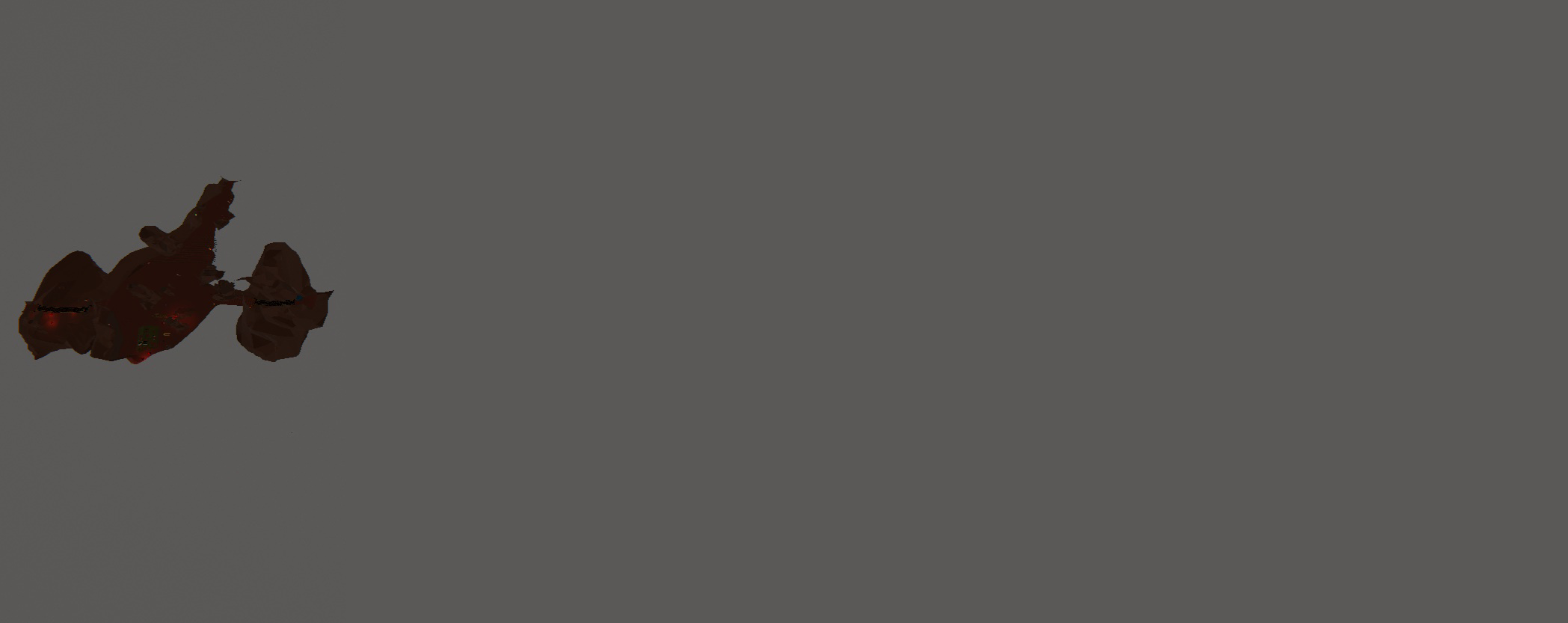
2. The next room is placed by choosing a random direction to offset it from this one. Attempts are made to place the next room close to a doorway of the current room to prevent too many sequences of long corridors in the level.
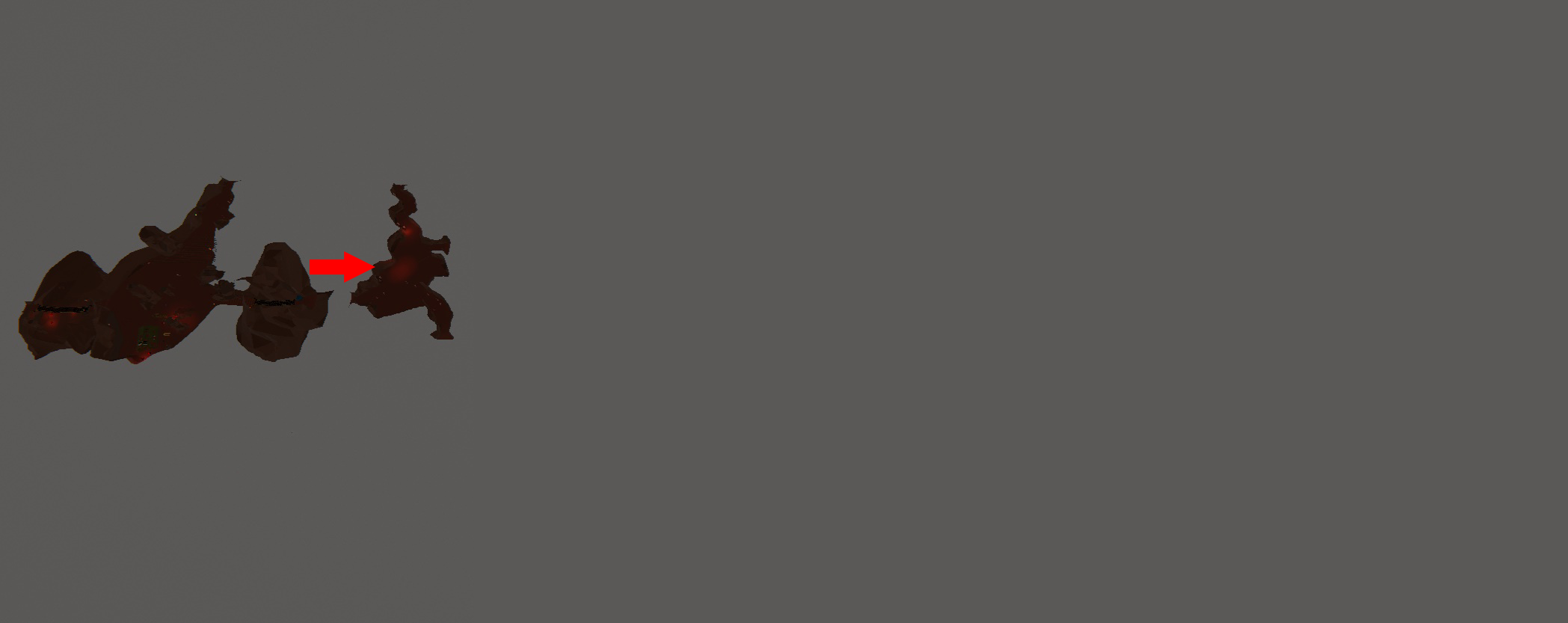
3. This process is repeated for all main rooms in a level with the randomised room offset direction being re-used each time and rotated within a certain range so that the level will have some ordered flow while still maintaining the ability to turn and intersect with itself in more chaotic ways over time.
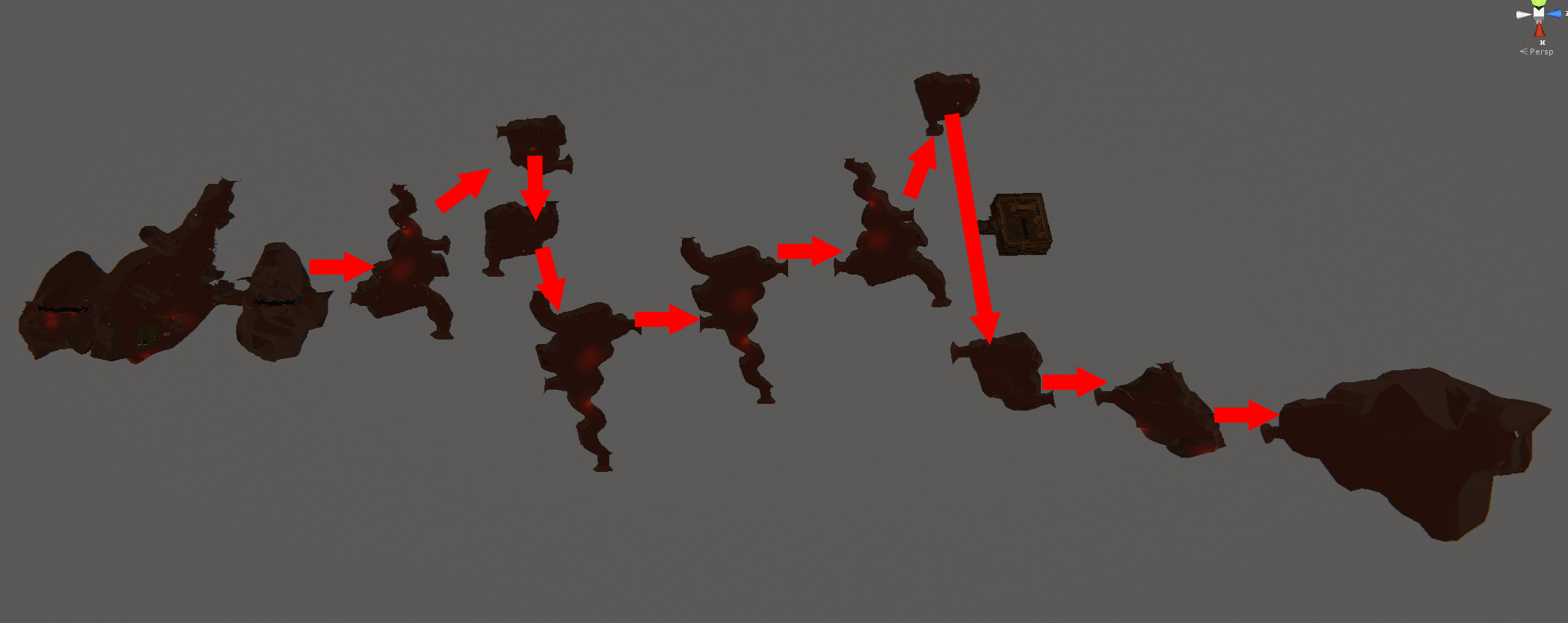
Some areas feature multiple levels of rooms and a certain number of rooms per level are created as stairway rooms connecting these. Also note the square-shaped room towards the end is ignored and bypass by the arrows here as that is a special room that will be covered at the end of this post.
The process of creating the rooms in an order with some loose restriction on a flow direction gives the ability to have the last room generally be the furthest from the starting room while also giving the ability for the flow to change enough to make this not the case and possibly provide earlier access to the exit room. The gameplay mechanics of Beneath make reaching the last room earlier not always desirable though. The order of rooms allows difficulty to ramp up over the course of a level through increases in numbers of enemies and the types of enemies you'll encounter.
Corridor Placement
Besides the snaking flow of room placement, the corridor generation also allows for rooms to be connected in a variety of ways that disrupt the initial room order. While the rooms shapes themselves aren't created with much size or shape restrictions, they contain metadata that gives them a tile-based shape which is used in the corridor generation pass. To create the corridors connecting rooms a pathfinding algorithm, much like what is used by the enemy AI to find their way through environments during gameplay, is used to traverse the tile grid from room to room.

In the above image you can see the result of the pathfinding algorithm. The rooms are connected to eachother based on their order, but you'll also note that there are some paths connected rooms that are not following the logical flow of the level. Depending on the initial arrangement of the rooms and various other randomised factors, rooms can be connected in many different ways with paths branching regularly. In this example even with a level that flows fairly linearly, the second room connects to the 3rd, 4th and 5th rooms and similarly the 6th room has a path to the 9th room allowing you to completely bypass the 7th and 8th rooms.
Even moreso than room placement there are many rules governing how the corridor paths are generated. The main reason for this is to limit bugs and unwanted path issues, but the other reason is to ensure corridor path shapes fall within certain predefined types. Like rooms, corridor pieces are pre-made models and these are placed to match the tiles occupied by the corridor generation step. Once the pathfinding is complete, a process of placing corridor pieces takes place. This can be quite complicated as there are many different shapes to account for all sorts of intersection possibilities and a strict order of operation must be followed in how the models are added to ensure full path coverage without any overlaps.
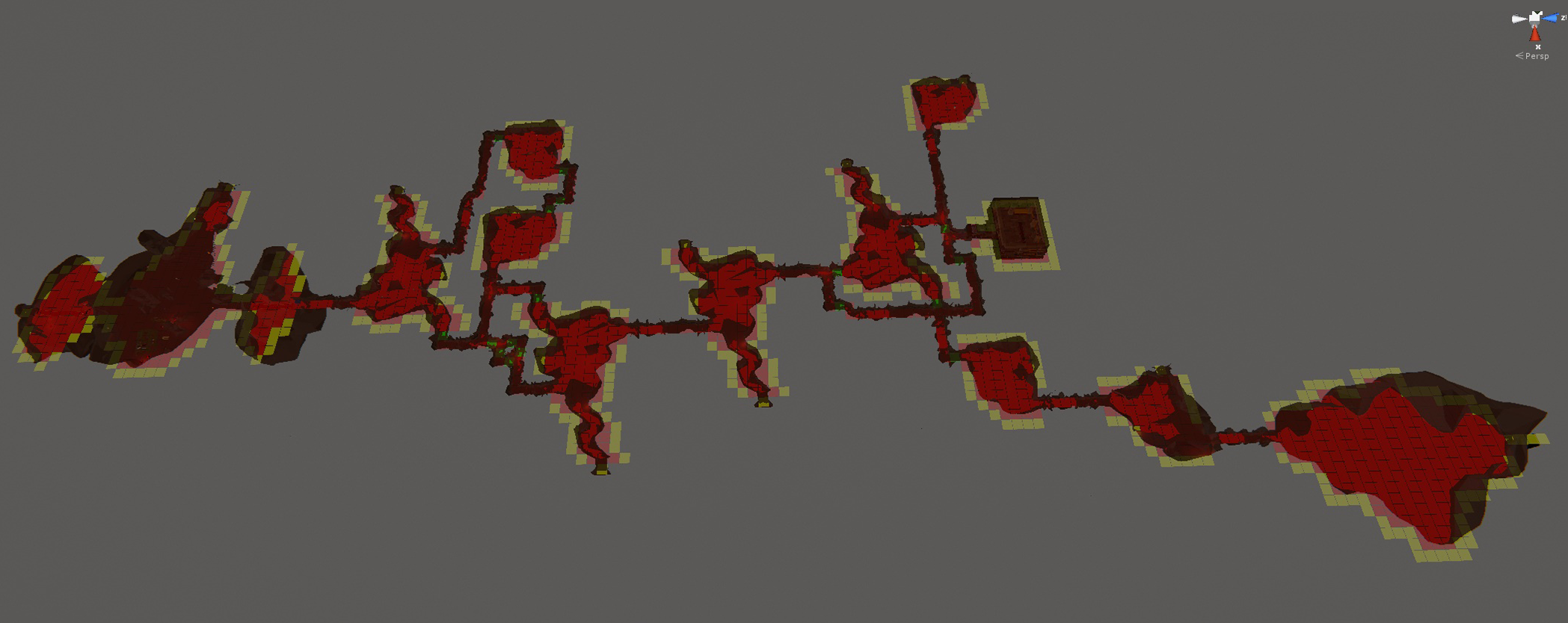
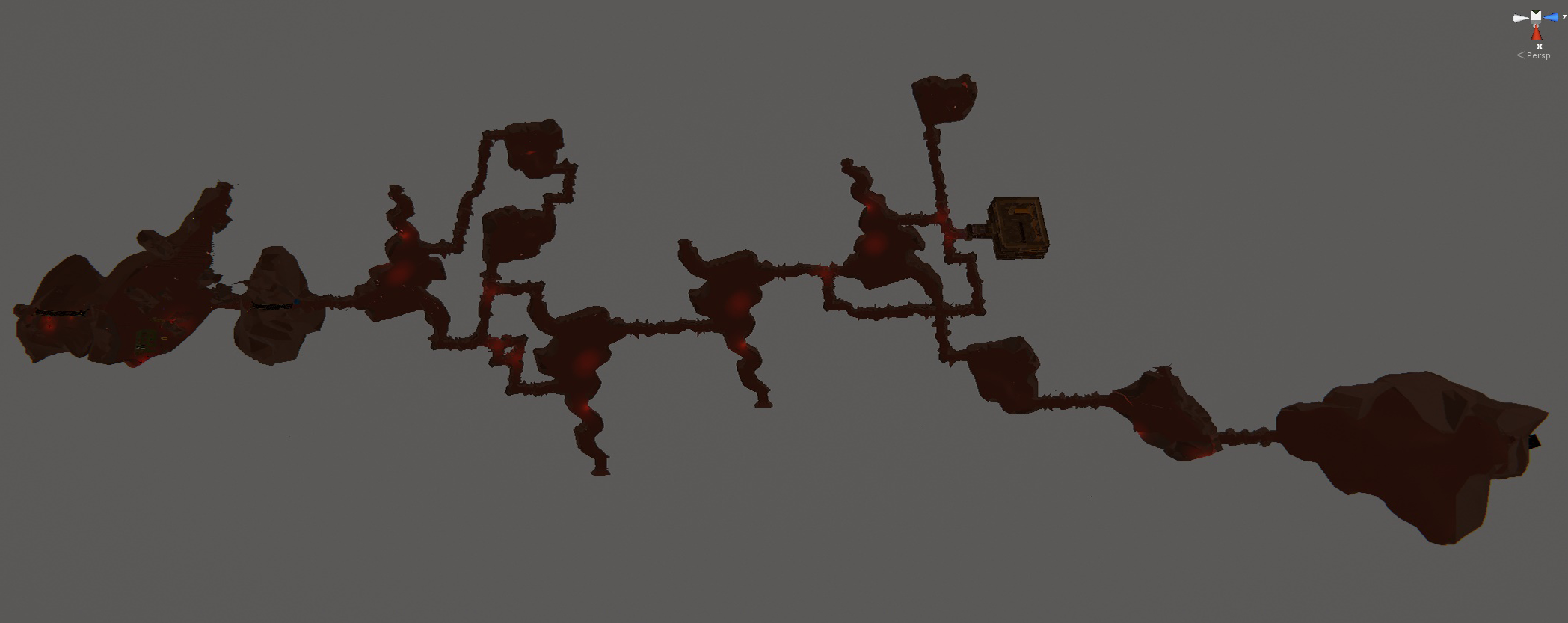
Additional Features
There's much more to a Beneath level than simply placing rooms in an order and corridors between them. Many levels will have intentional branches that lead to nowhere or to other secrets. Other levels take on a more hub-style approach where the starting room might be more central with the level going out from it in different directions.
One element that will be common that doesn't fall into the basics of the level layout is shops. Throughout Beneath you'll earn gold from defeating enemies and this can be spent both at standalone "vending machine"-style objects found randomly in rooms, or at a shop. Shop placement in a level is handled after all rooms are created and typically will insert itself into a spot where there is a longer corridor between rooms. In the example here you can see the shop has placed itself between the 8th and 9th rooms which are the furthest from eachother.
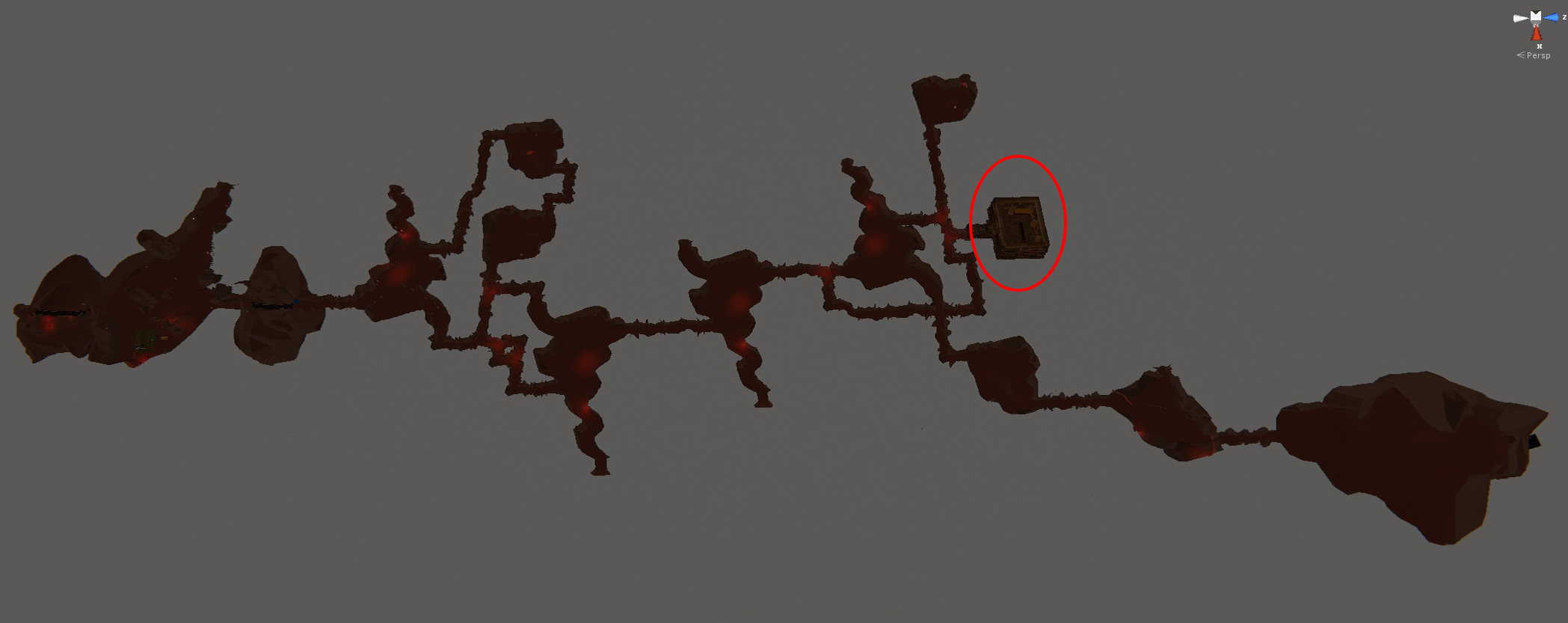
There are many more aspects to level generation with room variety and level structure usually being much greater and more complicated than what was shown in this example. We'll likely go into more detail on other aspects of this and on how other areas generate their levels in upcoming posts.
We're planning on releasing an update soon to bring the current state of the game closer to where it will be when Beneath is released. This is in order to ensure non-Beneath elements are working correctly and to minimise the amount of new things introduced at once when Beneath is released. There have been several significant engine upgrades since the last update and a lot of systems have been re-written to handle the greater variety of powers, enemies, weapons, etc. We'll detail more about what will be in this update in the next post.
In this post we'll briefly cover some of how levels in Beneath are created mainly from a high level overview of the technical aspects involved.
Level Generation Basics
The most common style of level in Beneath, the one you'll see in the first few areas, is created by connecting a number of randomly placed rooms with corridor pieces. This allows us to combine the benefits of pre-made rooms with the practically unlimited randomised layouts. In addition to randomising the layouts of levels we also randomise the types, counts and placement of enemies and items throughout the levels. These are governed by your progress through Beneath and how difficult it is supposed to be on that level.
Room Placement
There are some different ways in which rooms can be placed to allow for levels that flow in different ways. For the following example I've restricted the generation to using a limited set of room shapes and a basic level layout to more easily demonstrate room and corridor placement, but in a future preview post I'll cover the much greater variety of rooms available and the ways in which even the same rooms and corridors will appear completely different based on a large amount of flexibility with the environmental content of a room.
The most common way rooms will be placed is as follows:
1. The starting room for the level is placed.

2. The next room is placed by choosing a random direction to offset it from this one. Attempts are made to place the next room close to a doorway of the current room to prevent too many sequences of long corridors in the level.

3. This process is repeated for all main rooms in a level with the randomised room offset direction being re-used each time and rotated within a certain range so that the level will have some ordered flow while still maintaining the ability to turn and intersect with itself in more chaotic ways over time.

Some areas feature multiple levels of rooms and a certain number of rooms per level are created as stairway rooms connecting these. Also note the square-shaped room towards the end is ignored and bypass by the arrows here as that is a special room that will be covered at the end of this post.
The process of creating the rooms in an order with some loose restriction on a flow direction gives the ability to have the last room generally be the furthest from the starting room while also giving the ability for the flow to change enough to make this not the case and possibly provide earlier access to the exit room. The gameplay mechanics of Beneath make reaching the last room earlier not always desirable though. The order of rooms allows difficulty to ramp up over the course of a level through increases in numbers of enemies and the types of enemies you'll encounter.
Corridor Placement
Besides the snaking flow of room placement, the corridor generation also allows for rooms to be connected in a variety of ways that disrupt the initial room order. While the rooms shapes themselves aren't created with much size or shape restrictions, they contain metadata that gives them a tile-based shape which is used in the corridor generation pass. To create the corridors connecting rooms a pathfinding algorithm, much like what is used by the enemy AI to find their way through environments during gameplay, is used to traverse the tile grid from room to room.

In the above image you can see the result of the pathfinding algorithm. The rooms are connected to eachother based on their order, but you'll also note that there are some paths connected rooms that are not following the logical flow of the level. Depending on the initial arrangement of the rooms and various other randomised factors, rooms can be connected in many different ways with paths branching regularly. In this example even with a level that flows fairly linearly, the second room connects to the 3rd, 4th and 5th rooms and similarly the 6th room has a path to the 9th room allowing you to completely bypass the 7th and 8th rooms.
Even moreso than room placement there are many rules governing how the corridor paths are generated. The main reason for this is to limit bugs and unwanted path issues, but the other reason is to ensure corridor path shapes fall within certain predefined types. Like rooms, corridor pieces are pre-made models and these are placed to match the tiles occupied by the corridor generation step. Once the pathfinding is complete, a process of placing corridor pieces takes place. This can be quite complicated as there are many different shapes to account for all sorts of intersection possibilities and a strict order of operation must be followed in how the models are added to ensure full path coverage without any overlaps.


Additional Features
There's much more to a Beneath level than simply placing rooms in an order and corridors between them. Many levels will have intentional branches that lead to nowhere or to other secrets. Other levels take on a more hub-style approach where the starting room might be more central with the level going out from it in different directions.
One element that will be common that doesn't fall into the basics of the level layout is shops. Throughout Beneath you'll earn gold from defeating enemies and this can be spent both at standalone "vending machine"-style objects found randomly in rooms, or at a shop. Shop placement in a level is handled after all rooms are created and typically will insert itself into a spot where there is a longer corridor between rooms. In the example here you can see the shop has placed itself between the 8th and 9th rooms which are the furthest from eachother.

There are many more aspects to level generation with room variety and level structure usually being much greater and more complicated than what was shown in this example. We'll likely go into more detail on other aspects of this and on how other areas generate their levels in upcoming posts.
Next Update
We're planning on releasing an update soon to bring the current state of the game closer to where it will be when Beneath is released. This is in order to ensure non-Beneath elements are working correctly and to minimise the amount of new things introduced at once when Beneath is released. There have been several significant engine upgrades since the last update and a lot of systems have been re-written to handle the greater variety of powers, enemies, weapons, etc. We'll detail more about what will be in this update in the next post.
[ 2018-03-29 03:29:39 CET ] [Original Post]
Minimum Setup
- OS: 64-bit Ubuntu 20.04+/Equivalent or SteamOS
- Processor: 2 GHz 64-bit CPU
- Graphics: OpenGL 3.2+. Vulkan capable.
- Storage: 2 GB available spaceAdditional Notes: If you are on or around the min spec then you may need to run with Low graphics options and at a lower resolution.
GAMEBILLET
[ 6425 ]
GAMERSGATE
[ 3784 ]
MacGamestore
[ 2906 ]
FANATICAL BUNDLES
HUMBLE BUNDLES
by buying games/dlcs from affiliate links you are supporting tuxDB















































